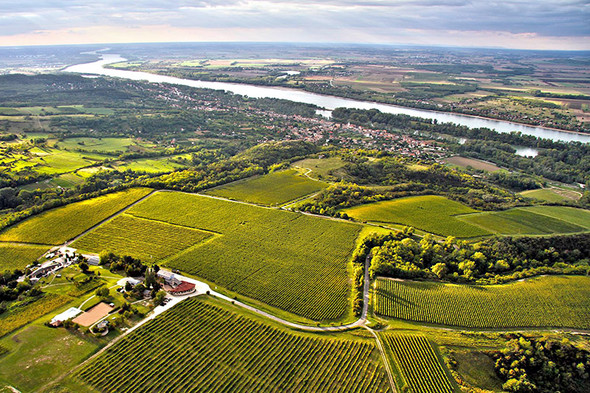The story of the Neszmély wine region in Hungary (or the Ászár-Neszmély wine region as it was called not so long ago) begins with Probus, the roman emperor who “deployed” his legions also for planting vineyards. Then the Hungarian conquest of the Carpathian basin and the early middle ages have not much useful information to offer. After 1410, Tata being part of the wine region and mainly its castle was a favourite residence of King Sigismund and if we can give credit to the contemporary documents, he did not despise the wines of the locality either. The settlement Bársonyos was held by the Pannonhalma Abbey at the time, and the neighbouring settlement Szőllős whose vineyards were annexed to Bársonyos to prevent the decay of vineyards was entirely destroyed in the first half of the 1400s. (These vineyards are assumed to form today Öreghegy.) Around that time Neszmély was also held by Sigismund and Ászár by the queen. The first Habsburg to follow Sigismund on the Hungarian throne was Albert II who died of dysentery on 27 October 1439 in Neszmély.
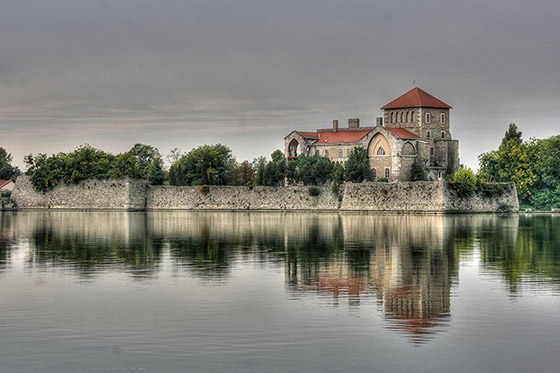
Following our defeat at the Battle of Mohács, the Turkish troops passing through the territory almost completely destroyed the settlements and their population, however according to a document from 1581, Ászár was again an important settlement held by Spahi Mehmed at that time. After the expulsion of the Turks, the area could just slowly come back to life. In 1727 Tata became a possession of the Esterházy family that settled not only Hungarians buts also Germans on the area. Bársonyos and its surroundings belonged to the Pannonhalma Abbey up until the middle of the 20th century while Neszmély was bought by the Zichy family in the middle of the 19th century, which is no wonder why according to a parochial chronicle dated in 1789 and written by the preacher of the village (Márton Beretzki):
The quantity and quality of wine was exceptionally outstanding. No such wines were produced since 1779, it is very sweet…
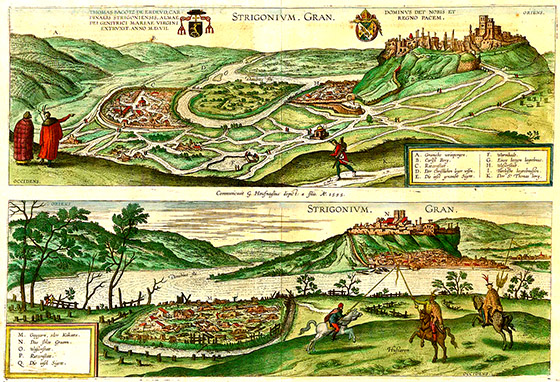
Ászár was acquired by the Esterházy family in 1712. The story of Esztergom, belonging also to this wine region, could fill a book in itself. But the least we can say is that the early royal then ecclesiastical centre was not spared by the Turkish conquest either and its true revival could only begin in 1820 when the Archbishop of Esztergom, who had formerly fled the town, returned from Nagyszombat (in 1543). Kesztölc and its environs had been held and, following the Turkish rule, were regained by the chapter of Esztergom. In 1832 Ferenc Schams wrote the following about the Neszmély wines: "The Neszmély wine is undisputedly the best wine of the Komárom district ispán (count), the noblest white table wine of Hungary and is well known both in Hungary and abroad both for its goodness and durability and for its mildly pleasant mountain taste. It was named after the inconsiderable village of Neszmély laying on the right of the Danube and to the East of the mountain range. This mountain is a promontory ranging from Csaba, bending in a half circle along the Danube through Almás to Dotis (Tata). The mountain is mainly of clay, sand and some detritus scattered here and there showing its back to the main mountain range and sloping towards the Danube." It was also Schams who concluded that as the location and the soil of the vineyards do not warrant a high quality, it may only be explained by the unique way of pruning as a result of which the farmers in Neszmély produce much less grapes than their counterparts in Buda. (It is a typical instance of contemporary yield control.) According to the writer the best wines were produced in Pap-hegy, but the wines of Meleges and Kásás-hegy had also been well-known before. In 1848 Elek Fényes wrote the following about Neszmély:
The majority of villages in the Tata district produce wines […]. The best of them all is the wine from Neszmély. Its main characteristic is that it is the best after aging for 4-5 years to show all its strengths and pleasant flavours for what it is so much loved by the people. The aging process is also facilitated by the good cellars. It is strange that the Neszmély mountain that should not be promising anything extraordinary based on its position (sloping towards the north and bordered by higher mountains on the south), soil composition (clay and sand) or grape varieties (mostly mézes [honey-sweet], fejér [white], muskotály [muscat] or dinka], yet its closeness to the Danube, its nice, moderate weather, the way the vineyard workers treat the grapes by pruning hard the shoots and growing less but good clusters of grape (though some have already left this tradition in an effort to increase the quantity instead of improving the quality) and especially the indecipherable secrets of nature produce such a nice nectar that is comparable to the most favoured dessert wines in Hungary.
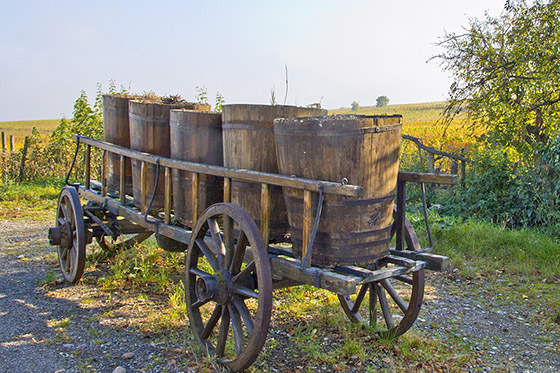
According to the data collected by Frigyes Pesty in 1864, the grapes of Neszmély were grown on the lower parts of Akasztó hill, Szömördök hill, in the Gárdony valley, on the lower parts and slopes of Kásás hill, in the Sertés valley, on the slopes of Barki hill, on Új-hegy, on the Korma slope, on Meleges, on the lower parts of Alsó and Felső Pap hills and Vár hill. The wines of this area that were easy to transport due to their high acidity made the region more and more known and maybe it was owing to this that in 1855 the Order of the Augustinian Canons of Klosterneuburg bought the estates and a part of the lands in Almás and Neszmély from the Zichy family. The flourishing was ended by phylloxera. Protection against it was helped by the Pannonhalma Abbey around Bársonyos and by the sample vineyard established by the Esterházy family at Ászár. Eventually, in 1897 Neszmély wine region was created including, at the time, the areas of today’s Mór, Pannonhalma and Etyek wine regions. In 1936, the minister for agriculture issued a decree confirming that the settlements belonging to the Neszmély wine region are: Neszmély, Nyergesújfalu, Süttő, Dunaalmás, Ászár, Bokod, Vérteskethely, Baj, Tárkány, Szomód, Esztergom and Bársonyos.
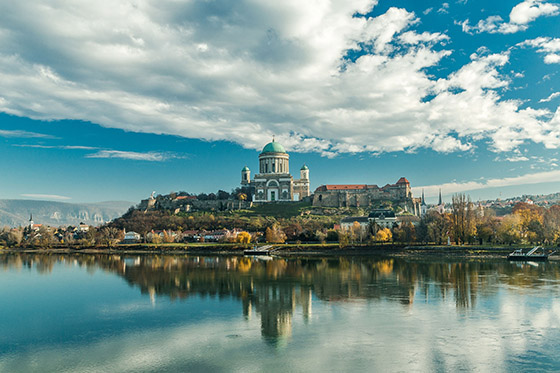
The upswing of the wine region after that was also owing to mainly Neszmély and the Meleges hill in the forties of the past century. In 1941, writer József Baranyai from Komárom wrote about the Palugyai, later Ziegler manor located there: "On the top of Meleges there is a vast table-land which is perfectly suitable for viticulture. It is well exposed to the sun explaining the origins of the name Meleges (warm). […] The Palugyai family established a large vineyard there […] and built a castle-like noble dwelling. There were stables and maid’s apartments here […]. The vaulted tunnels of vast cellars accommodated hundreds of huge barrels." Mass production during the communist era deteriorated the quality to such an extent that, losing its independent rank as a wine region, the area merged with the Básonyos-Császári wine region in the 1950s so that in 1977 it could renew and take on its old name as a result of newly planted vineyards. Following the change of regime, Hilltop Neszmély, the emblematic winery of the wine region was established from the Neszmély winery. Ákos Kamocsay, a shareholder and the winemaker of the winery, won the Winemaker of the Year trophy in 1999.
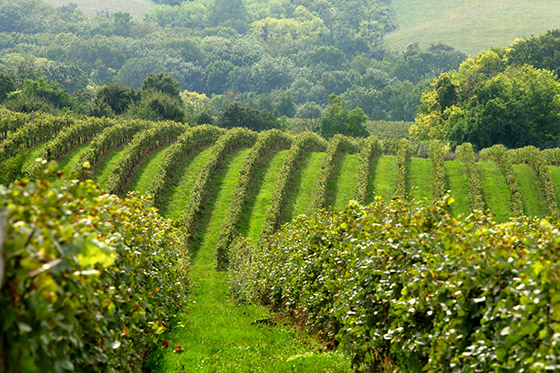
Geology
It is almost impossible to clearly delineate the Neszmély wine region geographically due to its segmentation. From the west to the east first we arrive to the Ászár district being the area of the Bársonyos hills. (However, many say that Bársonyos hill is not identical with Vértesalja. The former is separated from Vértesalja by the valley of Által-ér [brooklet] that takes its rise on the south of the settlement Császár and flows by Pusztavám to feed first Lake Bokodi then, a series of other lakes, namely Lake Környei, the reservoir of the power plant at Tatabánya, Lake Öreg in Tata, the Ferencmajor fish pond system next to Naszály just to reach the Danube between Almásfüzítő and Dunaalmás with two mouths.) The hills sloping towards the north are interspersed with erosion and derasion valleys and their highest point does not even reach 300 m. On the land of argillaceous and sandy lake deposit and of loess from the quaternary, the main soil forming rock of the vineyards is loess. On a major part of the area the soil is brown forest soil with clay infiltrated. The hills are bordered by Által-ér on the south, as already mentioned, Bakonyalja and Sokoró on the west and Gerecse on the east, while on the north it fits into the Igmánd-Kisbér basin. The wine region also expands to the area of the latter two. The argillaceous hills of the Igmánd-Kisbér basin are covered with loess and sandy deposit and this area is host to the settlements Nagyimánd, Csép and Kocs. This landscape is bordered on the north by the Győr-Tata terrace which, as the offset of Kisalföld, can be separated to a lower and a higher flood plain along the Danube and is mainly made of river deposit. (The settlement Mocsa is located on this area.) The core of the wine region can be found on the western and northern slopes of Gerecse. Similarly to Vérteskethely hidden within the Bársonyos hills, Vértesszőlős located on the Gerecse has nothing to do with the Vértes hills. The western side of the hills composed mainly of Dachstein limestone and dolomite are bordered by the peaks of Asszonyhegy (375 m) and Nagy-Somló (425 m) on the west, and on the south by Hosszúvontató, Nagy-Dobó-hegy, Agostyáni-hegy, Öreg-Kovács and Hajagos. The piedmonts are covered with loess up to an approximate height of 350 m and around the mouth of Által-ér and at Vértesszőlős, sinter can also be found. The hills are separated from the Vértes by the valley Tatai-árok and are bordered by the Zsámbék basin from the south and southeast, while its natural border on the north is the Danube. The area encircled by the settlements Dunaszentmiklós, Dunaalmás and Neszmély is the historical and, at the same time, current core of the wine region. Nagy-Somló, Korma-hegy (300m) and Meleges (274m) located in the outskirts of Neszmély are also the areas accommodating the most widely-known parcels of vineyards. The areas sloping towards the north are warmed by the sunrays reflected by the Danube and the north winds reduce the risk of fungi diseases. The argillaceous soil is rich in trace elements and minerals. On the northeast side of Gerecse, towards Süttő, Lábatlan, Nyergesújfalu and Bajót, vineyards were planted on sand ridges, and on the northern parts of limestone hills (facing the Danube) and a bit further off from the Danube on the southern piedmonts. A good example of this latter is Kő-alja dűlő (parcel of vineyard) laying on the southern slopes of Öreg-kő (374 m) to the east of Bajót. The vineyards of Tát lay on alluvial soil on the east from here, while the vineyards of Esztergom and Kesztölc are established on the limestone and dolomite blocks of the Pilis hills. It is true for the whole of the wine region that the climate conditions are moderate, the number of sunshine hours per year is around 2000, while the yearly precipitation is 550-650 mm.
Area of the wine region: 6600 Ha
Area covered with vineyards: approx. 1400 Ha
The settlements of the wine regions are divided into two districts:
The Ászár district: Ászár, Bársonyos, Császár, Csép, Ete, Keréktelki, Kisbér, Nagyigmánd, Vérteskethely
The Neszmély district: Baj, Bajót, Dunaalmás, Dunaszentmiklós, Esztergom, Kesztölc, Kocs, Lábatlan, Mocsa, Mogyorósbánya, Neszmély, Nyergesújfalu, Süttő, Szomód, Tata, Tát, Tokod, Vértesszőlős
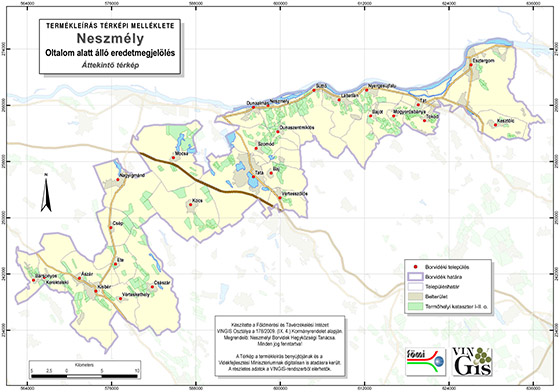
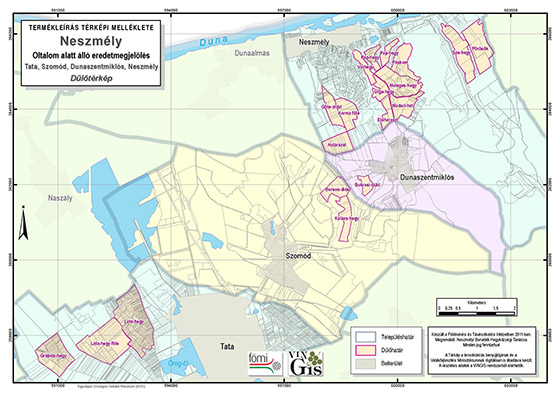
Diary of the wine region
Today the main representatives of the wine region are clearly Hilltop winery and wine maker Ákos Kamocsay. The winery selling nearly seven million bottles (of this six million in Great Britain) was made famous by its light, reductive white wines. For sure, the wine region is capable of offering more than that and maybe its past also predestines it to do more. Currently the main varieties are chardonnay, welschriesling, sauvignon blanc, pinot gris, cserszegi fűszeres, irsai olivér, gewürztraminer, leányka, királyleányka, ezerjó, riesling, so in other words almost every white varieties. There is also some cabernet, merlot and pinot noir, blaufränkisch and zweigelt, but these are no typical of the region. Wineries around Bársonyos in Császár, Bajót or Esztergom are still looking for their opportunities but in Kesztölc bottled wines are already available on the shelves of the cellars. Apropos cellars! Only a few know that the cellars of Neszémly (Sertés valley), Bársonyos (Öreg-hegy) or Kesztölc (Öreg-hegy), or the Tokodi Pincevölgy [lit. cellar valley of Tokod] are refreshing phenomena of the wine region and also offer a great destination to make a trip to. In the product descriptions, the wine region is mainly focused on Neszmély where twelve parcel names are protected trademarks, among them the famed Meleges-hegy, but Korma föle, Göte oldal, Madari hát, Ürge-hegy, Páskom, Pap-hegy and Várhegy are just as much remarkable areas. Hilltop has already started to communicate (so far only on its website) about Korma and Meleges-hegy, however the rise of wines typical of a particular parcel of vineyard (dűlő) to fame is yet to come. In addition, a parcel of vineyard in Dunaszentmiklós, two from Szomód and three from Tata were mentioned which is already more than what was expected. This is a forward-looking fact.
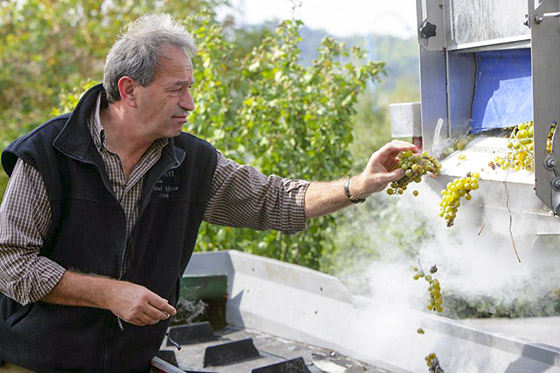
Conclusion
Currently there are two or three renowned participants and another 10-15 smaller almost unknown wineries on the market representing this wine region. Although the market conditions are by far not idealistic, but, considering the soil and climate, there is a favourable opportunity for further actors on this relatively scattered area to become widely known in Hungary. But for this, there is a need to find the image of the different landscapes of the wine region or, within it, the image of the individual wineries. Once Neszmély was famous for its durable white wines, today it is rather known for its light wines. I wonder what a family winery could create out of the legendary vineyards of Meleges-hegy? Can the famous aszú wine, Bársonyos Gyöngye be revived? Will there be a time again when Kesztölc wines will be on the tables of the provincialists of Esztergom. These questions are becoming more and more timely since the old stories are dormant for quite a long time now. It is up to the local wine makers if these stories will be revived again.



